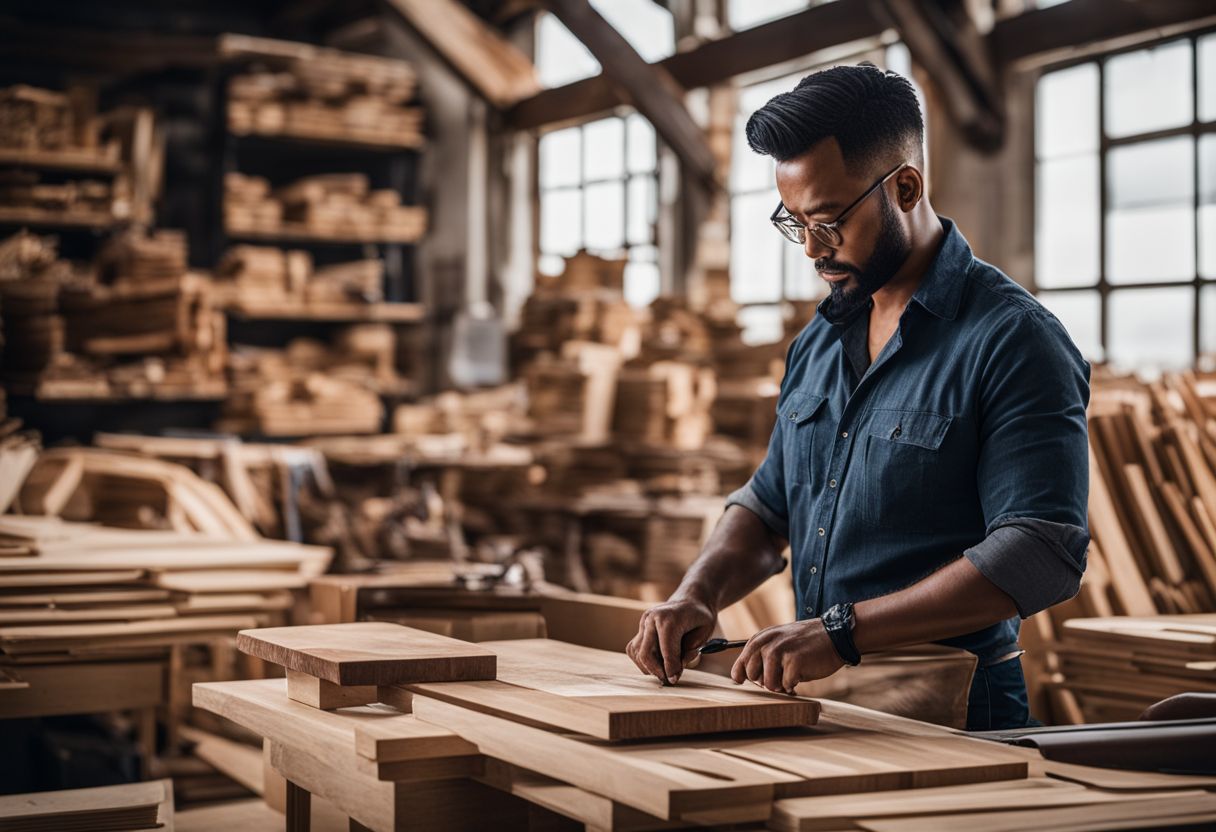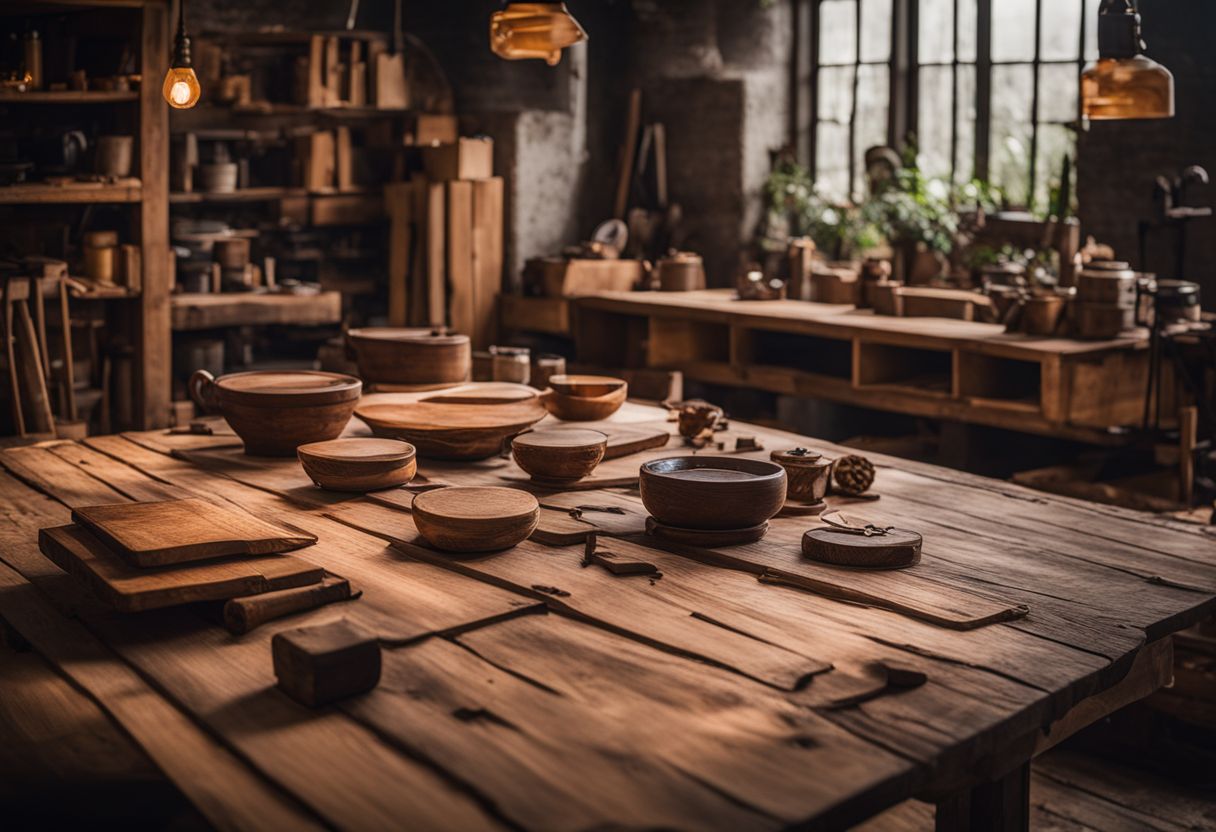Exploring Reasons: Why is Wood Furniture So Expensive Now in America?
Why is wood furniture so expensive now in america? Ever found yourself scratching your head, wondering why the price tag on that gorgeous wood furniture piece in America seems just a little too high? You’re definitely not alone. I’ve shared that same confusion myself.
After diving deep into some serious research, it turns out there’s more to the story: limited supply, skyrocketing demand spurred by pandemic-era home improvement projects, and those pesky supply chain disruptions are playing major roles.
So if you’ve got a minute, let’s unravel this mystery together – let’s dig deeper into what exactly is nudging those prices upward on our beloved wooden treasures.
Why is Wood Furniture So Expensive Now in America:
Key Takeaways
- Wood furniture prices in America are on the rise due to limited availability, high demand, inflation, and supply chain disruptions.
- Factors contributing to the higher cost of wood furniture include handmade craftsmanship, fair living wages for workers, high-quality materials, original design options, customization choices, support for American manufacturing, and heritage brands.
- Handmade craftsmanship is costly because it involves a time and labor – intensive process using specialized tools and requires attention to detail. Limited production capacity also adds to the price.
- Despite the rising costs of wood furniture, consumers value its longevity, quality, and unique design options.
The Rising Costs of Wood Furniture in America

Wood furniture prices have been on the rise in America due to a combination of factors, including lack of availability, high demand for quality pieces, and inflation and supply chain disruptions.
Lack of availability
Wood is hard to find these days. The pandemic made fewer workers get wood from the forest. This caused a shortage and limited supply of wood in America. Less wood means we cannot make as much furniture.
So, there is less inventory for sale. High demand and low supplies have pushed up prices in the wood furniture industry.
High demand for quality
People want top-notch wood furniture now more than ever. They crave the feel and look of a well-made piece in their homes. This high demand is part of why prices go up. Quality pieces last longer and have a great finish, which makes them cost more.
High-quality wooden furniture uses hot-ticket items like solid wood construction materials. But these can be costly, pushing up the price even further. The outbreak of COVID-19 has also bumped up the price of these types of supplies.
So, you are not only paying for quality but for all that it takes to make each piece.
Inflation and supply chain disruptions
The cost of wood furniture is going up because of inflation and supply chain problems. Inflation is when things cost more than before. This has hurt the furniture business a lot. It helps to make wood furniture more costly.
Also, we saw big issues with supply chains during the COVID-19 pandemic. A supply chain is how items get from factories to stores. The virus made it hard for people to work in these places safely which caused delays in shipping goods like wood and plywood, used for making furniture, too.
This was also one reason why prices rose sharply last year.
Factors Affecting the Price of Wood Furniture

Several factors contribute to the price of wood furniture, including handmade craftsmanship, fair living wages for workers, high-quality materials, original design, customization options, being made in the USA, heritage brands, and vintage or antique pieces.
Handmade craftsmanship
Handmade craftsmanship is one of the main factors contributing to the higher cost of wood furniture. When furniture is made by skilled artisans, it requires a lot of time and effort.
These craftsmen use specialized tools and pay close attention to detail, ensuring that each piece is meticulously crafted. Because handmade furniture involves such intricate work, it tends to have a limited production capacity compared to mass-produced items.
This exclusivity adds value and justifies the higher price tag. Additionally, handmade wood furniture is often considered to be of higher quality and durability compared to machine-made alternatives, which further drives up its price.
Fair living wages for workers
One important factor that affects the price of wood furniture is the payment of fair living wages to workers. In many factories where low- or mid-range furniture is produced, workers are not paid enough to meet their basic needs.
This can lead to exploitative labor practices and income inequality. By ensuring that workers receive a fair living wage, furniture manufacturers can promote ethical manufacturing practices and support local economies.
Paying fair wages also helps reduce poverty and improve overall social responsibility in the industry.
High-quality materials
High-quality materials play a significant role in determining the price of wood furniture. When it comes to plywood, kiln-dried hardwood layers are considered the best quality, which adds to the cost.
Solid wood construction materials are also used in high-quality wooden furniture, making them more expensive compared to other types of construction materials. The finish quality of wood furniture tends to be higher as well, contributing to its higher price tag.
Additionally, vintage and antique furniture’s popularity is influenced by the quality of materials used. Good build quality and carefully selected materials all impact the final price of wood furniture.
Original design
When it comes to wood furniture, the design of each piece plays a big role in its price. Unique and innovative designs tend to be more expensive because they require special attention and expertise from the artisans who create them.
These designs often involve intricate details, exquisite craftsmanship, and creative use of materials. Designers carefully consider factors like functionality, aesthetics, and ergonomics to make their pieces stand out.
Additionally, original designs give furniture makers a chance to showcase their creativity while also protecting their intellectual property rights. So, if you’re looking for a one-of-a-kind piece that will make a statement in your home, be prepared to invest in an original design that reflects true artistry and brings joy for years to come.
Customization options
Customizing wooden furniture to meet specific customer preferences adds to its price. Personalization choices such as selecting the type of wood, finish, and hardware require additional time and resources from the manufacturer.
This level of attention and detail increases the overall cost of the furniture. So, if you’re looking for a piece that is uniquely tailored to your needs, be prepared to pay a higher price for this added customization.
Made in USA
When it comes to wood furniture, the label “Made in USA” holds significant value. It indicates that the furniture is manufactured in America, contributing to local economies and supporting American jobs.
This emphasis on domestic production often leads to higher prices for these products. The factors affecting the price of wood furniture, such as handmade craftsmanship, fair wages for workers, and high-quality materials, are often prioritized by manufacturers in the United States.
Additionally, there is a sense of pride associated with owning furniture made in America due to its reputation for quality and adherence to safety standards. So while choosing wood furniture labeled “Made in USA” may come at a higher cost, it represents an investment in both the product’s durability and the support of American manufacturing.
Heritage brands
Heritage brands play a significant role in the rising costs of wood furniture. These brands often prioritize manual labor and craftsmanship, which can drive up prices. The materials used by heritage brands, such as solid wood, are typically more expensive compared to other options.
Additionally, rosewood, a commonly used wood in heritage brand furniture, has become costly due to high demand and rarity. So when you choose a piece from a heritage brand, you’re not only paying for quality craftsmanship but also for the history and reputation that comes with it.
Vintage or antique pieces
Vintage or antique pieces of wood furniture hold a special place in the market. They are sought after by collectors and enthusiasts for their historical significance and unique craftsmanship.
Vintage furniture shops, especially those specializing in midcentury modern styles, are facing increasing pressure due to rising prices and scarcity. Antique American furniture is highly valued and holds its own niche in the market.
European contemporary pieces, known for their record-breaking prices, also contribute to the overall rising costs of wood furniture. It’s important to appreciate the value of these vintage and antique pieces and recognize the skill and artistry behind them.
Why Handmade Craftsmanship Is Costly
Handmade craftsmanship is costly due to the time and labor-intensive process, specialized tools used, attention to detail required, and limited production capacity.
Time and labor-intensive process
Creating handmade furniture is a time and labor-intensive process. Skilled artisans carefully handcraft each piece, paying close attention to detail. They use specialized tools and traditional techniques to shape the wood into beautiful furniture pieces.
This level of craftsmanship takes hours upon hours of work, resulting in higher costs for the final product. The intricate joint construction in wood furniture also adds to the labor intensity, as it requires precision and skill.
These factors contribute to the overall price of handmade wooden furniture, but they also ensure that you’re getting a high-quality piece that will last for years to come.
Use of specialized tools
Handmade furniture requires the use of specialized tools to create unique and high-quality pieces. These tools are designed specifically for custom woodworking and fine craftsmanship.
They allow artisans to pay close attention to detail, resulting in furniture that is both beautiful and durable. Specialized tools also enable the creation of artistic designs and intricate joinery techniques that cannot be achieved with mass-produced furniture.
However, these tools come at a cost, which contributes to the overall price of handmade furniture. By using these specialized tools, craftsmen can ensure that each piece is made with precision and care, making it worth the investment.
Attention to detail
Crafting handmade wood furniture requires an incredible amount of attention to detail. Every aspect of the piece, from its design to its construction, is meticulously planned and executed.
As a result, the final product is a true work of art that showcases the skill and craftsmanship of the maker. Fine detailing, precision cuts, and carefully chosen materials all contribute to creating furniture that is not only beautiful but also durable and long-lasting.
The level of care put into each step ensures that every piece meets high-quality standards and exceeds expectations. Handmade furniture may be costly due to the time-consuming nature of this process, but it’s worth it for those who appreciate exquisite craftsmanship and unique designs.
Limited production
Limited production is a key factor in the higher cost of handmade furniture. This is because crafting furniture by hand requires a high level of skill and attention to detail, which takes time.
Additionally, limited production is influenced by the availability of hardwood for solid wood furniture, as hardwood grows more slowly. Obtaining these materials organically contributes to their higher cost.
However, it’s important to note that limited production doesn’t mean handmade furniture can’t be affordable or high-quality; skilled artisans can still create exquisite pieces despite this limitation.
Importance of Fair Living Wages for Workers
Paying fair living wages to workers is crucial for ensuring ethical and sustainable practices in the wood furniture industry while also supporting local economies.
Ensuring ethical and sustainable practices
When it comes to ensuring ethical and sustainable practices in the furniture industry, one important aspect is the fair living wages for workers. It means paying employees a wage that allows them to meet their basic needs and support themselves and their families.
This not only ensures fairness in the workplace but also helps reduce poverty and reliance on government assistance. By advocating for mechanisms that set national minimum wages at a level that equates to living wages, we can create an environment where economic growth is inclusive and sustainable.
Additionally, sustainable manufacturing includes other ethical practices such as fair labor, safe working conditions, supporting local communities, and using environmentally friendly materials.
Supporting local economies
Supporting local economies is crucial for the growth and prosperity of our communities. When businesses pay fair living wages to workers, it not only improves their economic security but also boosts the overall economy.
By providing employment opportunities and ensuring workers’ rights, we can create a stronger middle class and reduce poverty rates. Additionally, when people have more money to spend, they can support other local businesses which further stimulates the local economy.
This sustainable development benefits everyone involved and helps address economic inequality in our society.
Impact of High-Quality Materials on Furniture Prices
High-quality materials contribute to the higher prices of wood furniture due to their strong and durable construction, beautiful and unique grain patterns, and the use of sustainably sourced materials.
Strong and durable construction
Wood furniture is known for its strong and durable construction. It is typically made from solid wood or hardwood, which gives it superior strength and stability. The use of high-quality materials and construction techniques makes wooden furniture more expensive than other types of furniture.
Solid wood construction requires the best parts of the tree, resulting in higher production costs. However, the durability factor of wooden furniture makes it a sought-after choice for many people who want long-lasting pieces that can withstand daily use.
So, if you’re looking for furniture that will stand the test of time, investing in well-made wooden pieces with sturdy construction is worth considering.
Beautiful and unique grain patterns
High-quality wood furniture often stands out because of its beautiful and unique grain patterns. These patterns are the natural texture and design found in the wood itself, making each piece of furniture distinct and visually appealing.
For example, oak wood is highly sought after due to its aesthetic appeal and high demand, resulting in more expensive prices. Burl wood is also trendy because it has a distinct and unique grain pattern that adds character to furniture pieces.
These grain patterns contribute to the overall aesthetics of wood furniture and make them desirable choices for those looking for something special.
Sustainably sourced materials
Using sustainably sourced materials in the production of wood furniture is crucial for minimizing environmental impact and promoting long-term sustainability. By choosing to use materials that are responsibly harvested and managed, we can help protect our forests and ensure their continued health for future generations.
Sustainable sourcing also has economic benefits, as it encourages cost reduction through waste reduction and efficiency improvement. Additionally, using high-quality materials not only enhances the overall product quality but also promotes consumer trust and satisfaction.
So, by prioritizing sustainably sourced materials, we contribute to a healthier environment while enjoying beautiful, durable furniture that will stand the test of time.
The Value of Original Designs
Original designs add value to wood furniture by protecting intellectual property rights, driving innovations in design and functionality, and differentiating it from mass-produced alternatives.
Intellectual property rights
Intellectual property rights play a crucial role in the world of furniture design. These rights protect original designs and innovations, ensuring that creators have control over their work.
When it comes to furniture, these rights can include patents, copyrights, and design rights. For example, if a furniture designer creates a unique chair design and obtains a patent for it, they have the exclusive right to manufacture and sell that chair.
This helps prevent others from copying their designs without permission or proper licensing. It’s important because it encourages creativity and innovation while also protecting the hard work of designers.
Furniture designers put in a lot of effort to come up with new ideas and concepts for their pieces. They invest time, money, and resources into creating something unique that sets them apart from mass-produced furniture.
Intellectual property rights allow them to safeguard their creations against unauthorized copying or imitation. By respecting these rights, we support the value of original designs in the furniture industry and encourage further innovation in this field.
(KEYWORDS: Intellectual property rights – The Value of Original Designs,
Innovations
Protected
Innovations in design and functionality
Innovations in design and functionality have played a significant role in the rising costs of wood furniture in America. Creative designs and functional improvements have made furniture more unique and desirable, leading to higher prices.
Manufacturers are constantly coming up with cutting-edge designs and innovative features that set their products apart from mass-produced furniture. High-quality craftsmanship ensures that these designs are brought to life with attention to detail and ingenuity.
As a result, customers are willing to pay more for furniture that not only looks great but also offers enhanced functionality. So, when you invest in wood furniture with innovations in design and functionality, you’re getting a piece that stands out and adds value to your home.
Differentiation from mass-produced furniture
Differentiation is an important concept in the furniture industry. It means making furniture that stands out from mass-produced pieces. For example, Smithfield uses differentiation to set themselves apart.
They create unique designs and use high-quality materials, giving their furniture a distinctiveness that you won’t find in mass-produced items. This adds value to their products because customers appreciate the craftsmanship and artistry involved in creating something original and different.
By focusing on differentiation, Smithfield offers furniture with a personal touch, allowing individuals to express their own style and preferences through their home decor choices.
Cost of Customization Options
Customizing wood furniture to suit specific customer preferences can result in added costs, but it allows for a truly personalized piece that reflects individual style and needs. Discover why customization options play a significant role in the price of wood furniture.
Catering to specific customer preferences
Understanding and catering to specific customer preferences is a vital aspect of the wood furniture industry. When we personalize products and tailor them to meet individual customer needs, it can result in higher production costs.
By addressing customer requirements and adapting to their specifications, we are able to fulfill unique customer requests. This may involve customizing wood furniture pieces according to customer tastes, desires, and design preferences.
Offering customization options is important in meeting the demands of our customers, but it can contribute to the rising costs of wood furniture. We strive to accommodate our customers’ desires while ensuring that each piece reflects their personal style and preferences.
Additional time and resources
Customization options for wood furniture require additional time and resources. When customers want specific features or modifications, it takes longer for craftsmen to create those designs.
This includes using specialized tools and paying close attention to detail to ensure a high-quality finished product. These customizations require more effort, which ultimately adds to the cost of the furniture.
However, this extra investment is justified because it allows customers to have furniture that meets their unique preferences and needs, making it worth the higher price tag.
The Significance of “Made in USA”
Supporting American manufacturing not only ensures quality and safety standards but also contributes to job creation and economic growth. Find out why buying furniture made in the USA is a valuable investment.
Supporting American manufacturing
As a consumer, I believe in supporting American manufacturing because it has many benefits. When we buy products that are made in the USA, we are not only getting high-quality items, but we are also helping to support local industries and create jobs for our fellow Americans.
Additionally, by choosing homegrown products, we can have confidence in their quality and safety standards. It’s also a matter of national pride to invest in our own economy and ensure sustainable production practices.
So next time you’re shopping for furniture or any other product, consider the value of “Made in USA” and the positive impact it can have on our communities and country as a whole.
Ensuring quality and safety standards
I believe that ensuring quality and safety standards is crucial when it comes to wood furniture, especially if it’s made in the USA. American-made furniture has a reputation for being of higher quality compared to imported options.
This is because manufacturers in the US have to follow strict manufacturing standards and product safety regulations. It gives consumers confidence knowing that their furniture meets certain quality assurance measures.
Additionally, supporting domestic production helps local industries thrive and contributes to the economy. By choosing furniture made in America, you can also have more visibility into the supply chain transparency and ensure that workers are paid fair wages for their craftsmanship.
So, opting for “Made in USA” not only means getting a well-crafted piece of furniture but also making an ethical choice that supports local communities and upholds certain quality standards.
Conclusion
In conclusion, the increasing costs of wood furniture in America can be attributed to several factors. These include the limited availability of high-quality hardwood, supply chain disruptions caused by the COVID-19 pandemic, and high demand for wood products.
Additionally, factors such as handmade craftsmanship, fair living wages for workers, high-quality materials, original designs, customization options, support for American manufacturing, and heritage brands contribute to the higher prices of wood furniture.
Despite these rising costs, consumers continue to value the longevity, quality, unique design options offered by wood furniture.
FAQs
1. Why is wood furniture more expensive now in America?
Wood furniture is more expensive now in America due to factors such as increased material costs, higher labor expenses, and supply chain disruptions.
2. What are the factors contributing to the rising costs of wood furniture?
The rising costs of wood furniture are influenced by factors like high demand for raw materials, scarcity of certain wood species, transportation expenses, and inflation.
3. Will the prices of wood furniture continue to increase?
It is difficult to predict future prices accurately, but considering ongoing market conditions and various economic factors, it’s possible that wood furniture prices may continue to rise.
4. Are there any alternatives to expensive wood furniture?
Yes, there are alternatives to expensive wood furniture such as engineered or composite materials that mimic the look of real wood at a lower cost.
5. Is buying used or refurbished wood furniture a cost-effective option?
Buying used or refurbished wood furniture can be a cost-effective option since it usually comes at a lower price compared to new pieces while still providing functional and aesthetic value.







